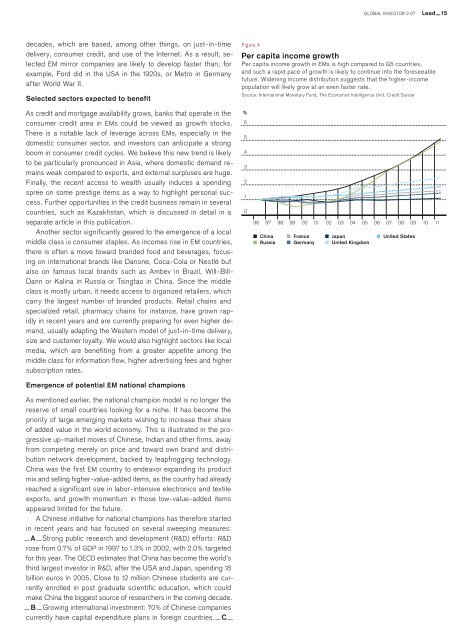Create successful ePaper yourself
Turn your PDF publications into a flip-book with our unique Google optimized e-Paper software.
GLOBAL INVESTOR 2.07 Lead — 15<br />
decades, which are based, among other things, on just-in-time<br />
delivery, consumer credit, and use of the Internet. As a result, selected<br />
EM mirror companies are likely to develop faster than, for<br />
example, Ford did in the USA in the 1920s, or Metro in Germany<br />
after World War II.<br />
Selected sectors expected to benefit<br />
As credit and mortgage availability grows, banks that operate in the<br />
consumer credit area in EMs could be viewed as growth stocks.<br />
There is a notable lack of leverage across EMs, especially in the<br />
domestic consumer sector, and investors can anticipate a strong<br />
boom in consumer credit cycles. We believe this new trend is likely<br />
to be particularly pronounced in Asia, where domestic demand remains<br />
weak compared to exports, and external surpluses are huge.<br />
Finally, the recent access to wealth usually induces a spending<br />
spree on some prestige items as a way to highlight personal success.<br />
Further opportunities in the credit business remain in several<br />
countries, such as Kazakhstan, which is discussed in detail in a<br />
separate article in this publication.<br />
Another sector significantly geared to the emergence of a local<br />
middle class is consumer staples. As incomes rise in EM countries,<br />
there is often a move toward branded food and beverages, focusing<br />
on international brands like Danone, Coca-Cola or Nestlé but<br />
also on famous local brands such as Ambev in Brazil, Will-Bill-<br />
Dann or Kalina in Russia or Tsingtao in China. Since the middle<br />
class is mostly urban, it needs access to organized retailers, which<br />
carry the largest number of branded products. Retail chains and<br />
specialized retail, pharmacy chains for instance, have grown rapidly<br />
in recent years and are currently preparing for even higher demand,<br />
usually adapting the Western model of just-in-time delivery,<br />
size and customer loyalty. We would also highlight sectors like local<br />
media, which are benefiting from a greater appetite among the<br />
middle class for information flow, higher advertising fees and higher<br />
subscription rates.<br />
Figure 4<br />
Per capita income growth<br />
Per capita income growth in EMs is high compared to G5 countries,<br />
and such a rapid pace of growth is likely to continue into the foreseeable<br />
future. Widening income distribution suggests that the higher-income<br />
population will likely grow at an even faster rate.<br />
Source: International Monetary Fund, The Economist Intelligence Unit, Credit Suisse<br />
%<br />
6<br />
5<br />
4<br />
3<br />
2<br />
1<br />
0<br />
96 97 98 99 00 01 02 03 04 05 06<br />
07 08<br />
China France Japan United States<br />
Russia Germany United Kingdom<br />
09 10 11<br />
Emergence of potential EM national champions<br />
As mentioned earlier, the national champion model is no longer the<br />
reserve of small countries looking for a niche. It has become the<br />
priority of large emerging markets wishing to increase their share<br />
of added <strong>value</strong> in the world economy. This is illustrated in the progressive<br />
up-market moves of Chinese, Indian and other firms, away<br />
from competing merely on price and toward own brand and distribution<br />
network development, backed by leapfrogging technology.<br />
China was the first EM country to endeavor expanding its product<br />
mix and selling higher-<strong>value</strong>-added items, as the country had already<br />
reached a significant size in labor-intensive electronics and textile<br />
exports, and growth momentum in those low-<strong>value</strong>-added items<br />
appeared limited for the future.<br />
A Chinese initiative for national champions has therefore started<br />
in recent years and has focused on several sweeping measures:<br />
—A—Strong public research and development (R&D) efforts: R&D<br />
rose from 0.7% of GDP in 1997 to 1.3% in 2002, with 2.0% targeted<br />
for this year. The OECD estimates that China has become the world’s<br />
third largest investor in R&D, after the USA and Japan, spending 18<br />
billion euros in 2005. Close to 12 million Chinese students are currently<br />
enrolled in post graduate scientific education, which could<br />
make China the biggest source of researchers in the coming decade.<br />
—B—Growing international investment: 70% of Chinese companies<br />
currently have capital expenditure plans in foreign countries.—C—

















